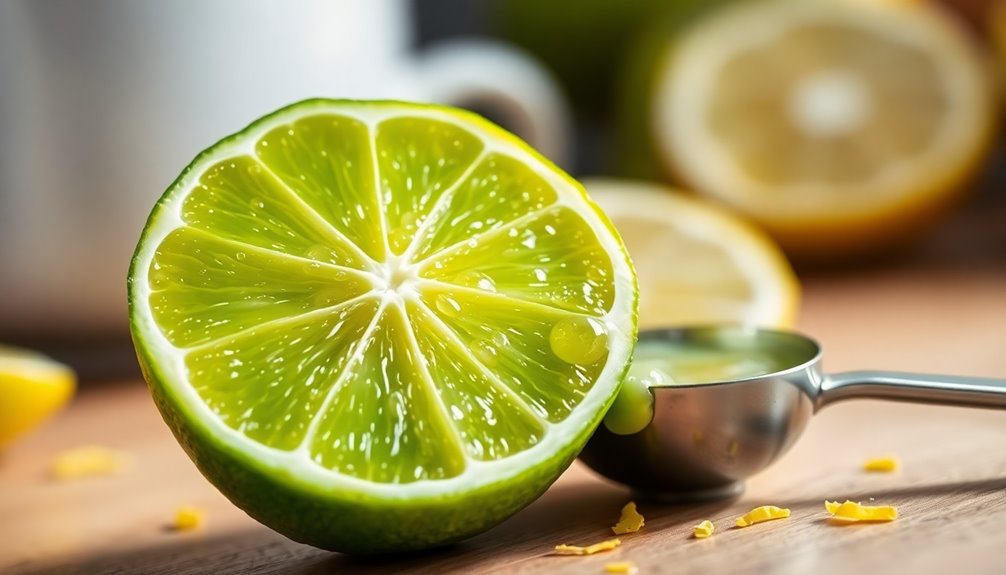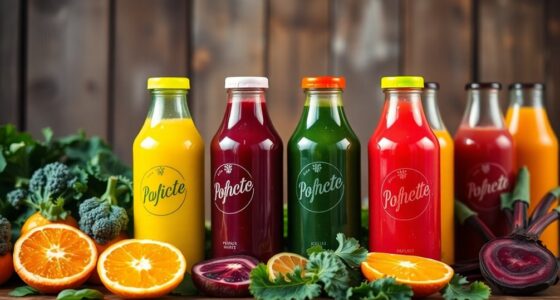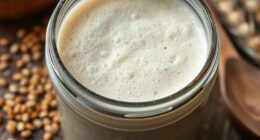A medium lime usually gives you about 6 teaspoons of juice. Persian limes are your best bet for a higher yield, while smaller varieties like Key limes provide less. To maximize extraction, try rolling the lime on a countertop or microwaving it for a brief period before juicing. Fully ripe limes also tend to yield more juice. Want to learn tips on selecting the right lime or optimizing your juicing techniques? Keep exploring!
Key Takeaways
- A medium Persian lime yields approximately 2 tablespoons of juice, equating to about 6 teaspoons.
- Key limes yield between 1 to 1.5 tablespoons of juice, or 3 to 4.5 teaspoons.
- Finger limes typically provide around 1 tablespoon of juice, which is about 3 teaspoons.
- Lime size, ripeness, and variety significantly influence the amount of juice produced.
- Techniques like rolling, microwaving, and using electric juicers can optimize juice extraction from limes.
Understanding Lime Juice Yield
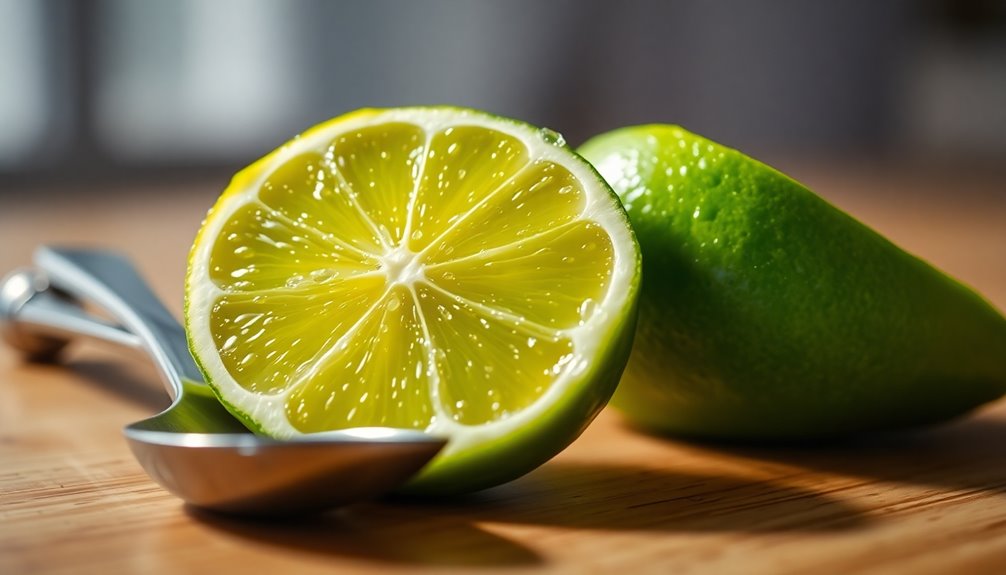
When you think about lime juice yield, it's crucial to recognize that different lime varieties can significantly impact how much juice you can extract. Persian limes, the most commonly found, are larger and seedless, yielding about 2 tablespoons of juice. In contrast, Key limes are smaller and more aromatic, offering only 1 to 1.5 tablespoons due to their seeds. Finger limes, with their unique caviar-like appearance, provide around 1 tablespoon of juice. Additionally, factors like size, ripeness, and freshness play a role in how much juice you can get. Larger limes typically yield more juice than smaller ones.
Measuring Lime Juice in Teaspoons
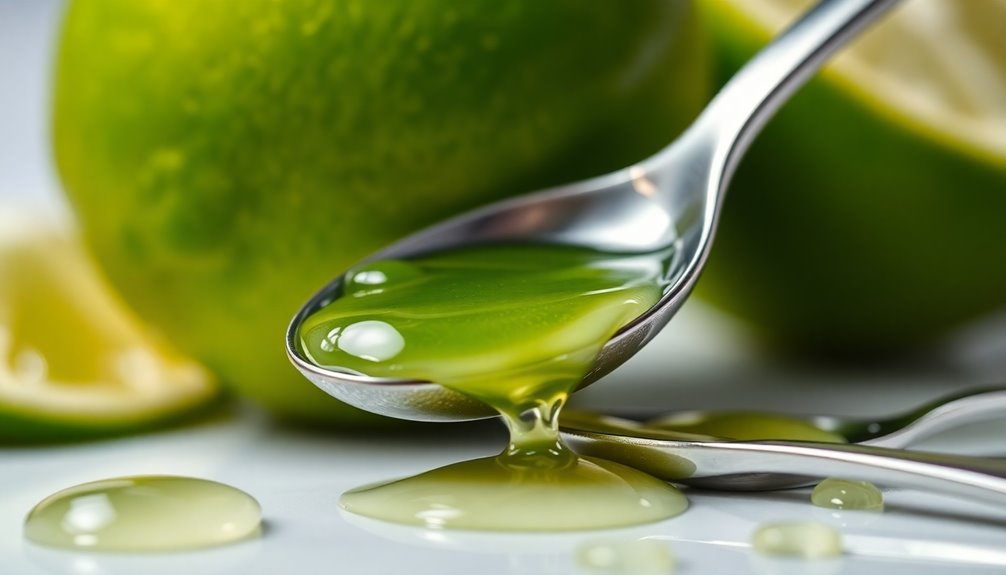
Knowing how much lime juice you can extract from a lime helps when measuring it in teaspoons. A medium lime typically yields about 2 tablespoons of juice, which equals approximately 6 teaspoons. This conversion is essential, especially since many recipes call for lime juice in teaspoons to ensure precise flavoring. You’ll often see 1-2 teaspoons per serving mentioned, and accurate measurement is crucial for consistent taste. Additionally, a medium lime can provide enough juice for multiple servings, making it a versatile ingredient in cooking and cocktails. To maximize your yield, consider using lime juice extraction tips such as rolling the lime on a hard surface before cutting it. This technique helps to break down the pulp and release more juice. Additionally, using a citrus reamer or a press can significantly enhance the amount of juice you can extract, ensuring that you get every last drop for your recipes.
Factors Affecting Juice Production
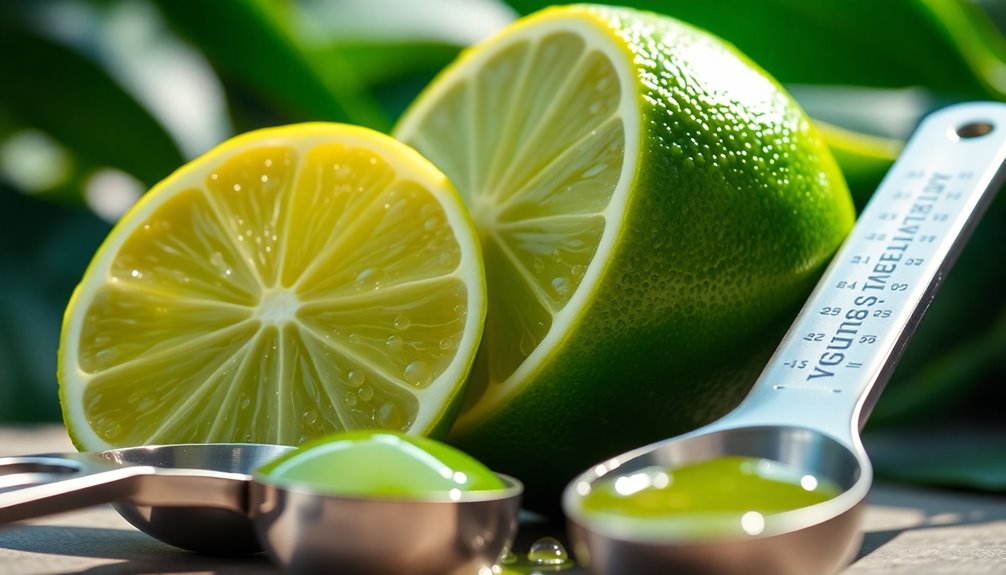
Several factors come into play when determining how much juice you can extract from a lime.
First, the size and variety of the lime matter; larger Persian limes typically yield more juice than smaller Key limes.
Ripeness is crucial too—fully ripe limes are softer and heavier, indicating higher juice content.
Your juicing technique also impacts the yield; electric juicers are generally the most efficient.
Environmental conditions, like temperature and humidity, affect the peel thickness, which can influence juice output.
Lastly, practices like proper fertilization and timely harvesting ensure optimal juice production. Additionally, antioxidants in citrus can play a role in enhancing overall health, making the juice not only refreshing but also beneficial.
Types of Limes and Their Juice Output
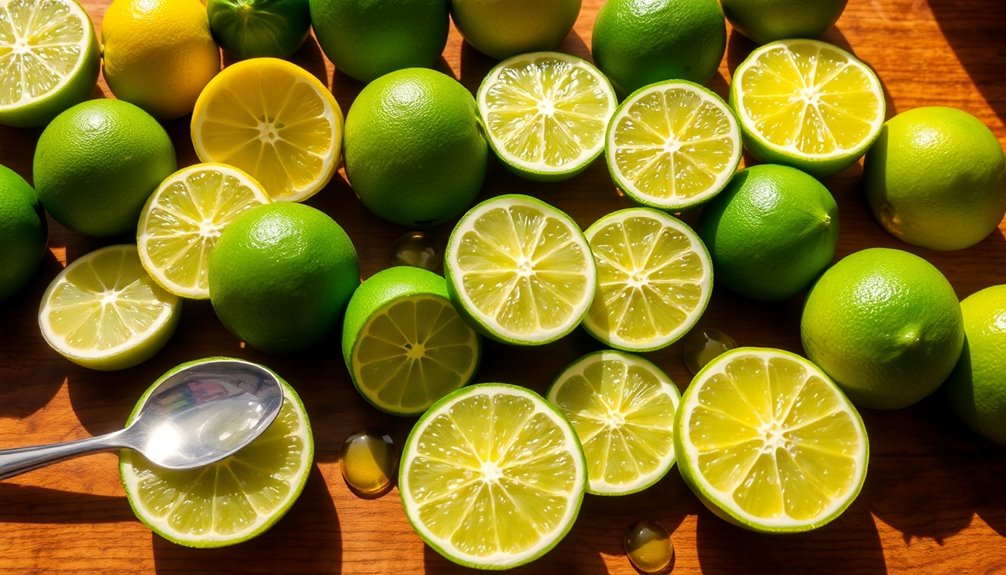
Understanding the different types of limes can significantly affect your juice output. Each variety has unique characteristics, making some more suitable for your needs than others. Here's a quick comparison:
| Lime Type | Size | Juice Yield |
|---|---|---|
| Persian Limes | Large | About 2 tablespoons |
| Key Limes | Small | About 1 to 1.5 tbsp |
| Finger Limes | Small | About 1 tablespoon |
Techniques for Optimizing Juice Extraction
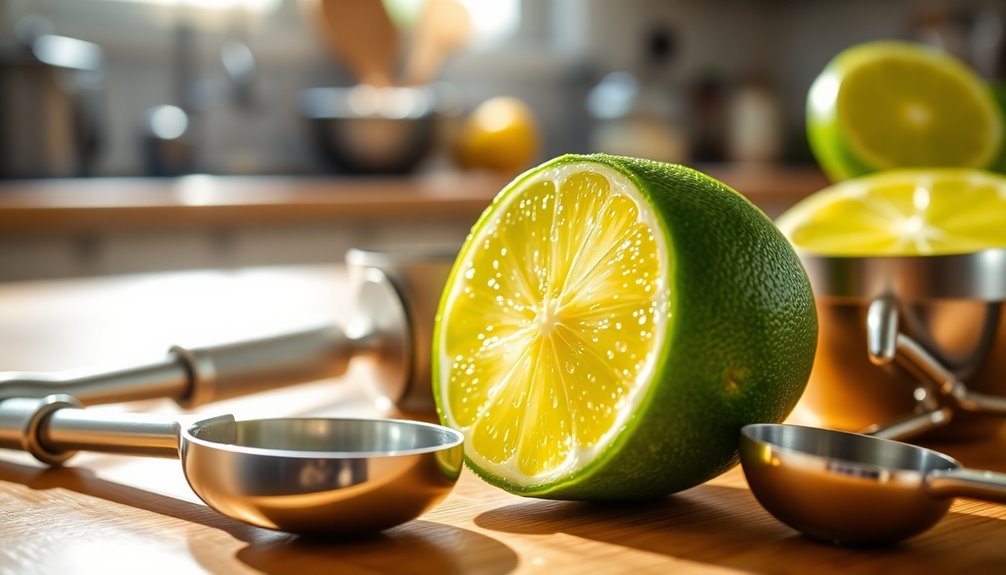
To optimize juice extraction from limes, you can employ a variety of techniques that enhance yield and efficiency.
Start by rolling limes on a countertop to loosen the membranes, or microwave them for 20-25 seconds to achieve the same effect. Using limes at room temperature makes them softer and easier to juice. Additionally, the juice from limes is packed with vitamin C, which can be a great health benefit.
When slicing, cut limes lengthwise for better extraction. For manual juicing, hand-held reamers or the fork method over a sieve can work wonders.
If you're looking for ease, electric citrus juicers offer high yields with minimal effort. Remember to choose smooth-skinned, green limes for optimal juice extraction.
Each of these methods can significantly improve your lime juice yield.
Culinary Uses of Lime Juice
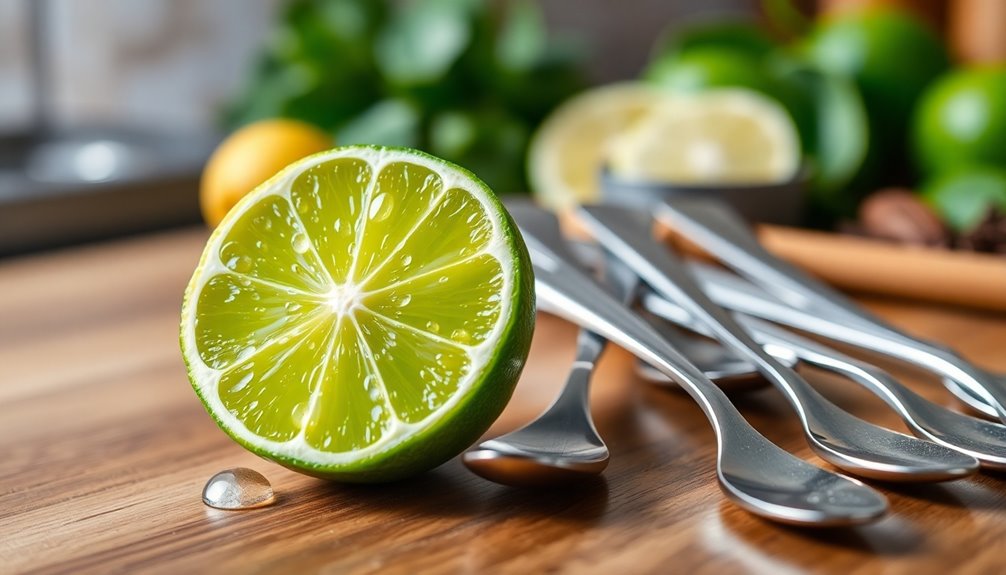
Lime juice plays a crucial role in elevating the flavors of countless dishes, making it a must-have in your culinary arsenal. You can use it in marinades for meats like chicken and shrimp, where its tangy zest truly shines. Lime juice can be used to enhance the flavor of corn-on-the-cob when squeezed over salted, buttered kernels.
In salads, lime juice adds a refreshing acidity that enhances dressings beautifully. When preparing seafood, it brings out the best in grilled salmon and shrimp.
Don't forget its role in beverages; lime juice is essential for refreshing drinks like limeade and classic cocktails. You can even incorporate it into desserts, such as key lime pie, for a delightful tartness.
Mixing lime with herbs or spices can create exciting flavor combinations that elevate any dish.
Frequently Asked Questions
Can I Use Bottled Lime Juice Instead of Fresh?
You can definitely use bottled lime juice instead of fresh, but keep in mind the differences.
Bottled juice offers convenience and consistency, making it great for quick recipes. However, it often lacks the vibrant flavor and nutritional benefits of fresh lime juice.
If you're looking for a zesty, bright taste, fresh limes are worth the extra effort. Ultimately, it depends on your recipe and preference for flavor versus convenience.
How Should I Store Leftover Lime Juice?
To store leftover lime juice, you've got a few options.
You can refrigerate it for 4-5 days in an airtight container, freeze it in ice cube trays for months, or even mix in some salt to help preserve it at room temperature for up to two weeks.
Always minimize air exposure to keep it fresh and flavorful.
Choose the method that fits your needs, and enjoy your lime juice longer!
What Are the Health Benefits of Lime Juice?
Lime juice offers numerous health benefits that you'll appreciate. It boosts digestion by stimulating saliva production and can relieve constipation.
The vitamin C content enhances your immune system, helping you fight infections and reduce illness duration.
Additionally, lime juice supports skin health by promoting collagen production and hydration.
It also aids in weight loss and prevents kidney stones, making it a fantastic addition to your diet for overall wellness.
Can Lime Juice Be Used in Baking?
Yes, you can definitely use lime juice in baking! It adds a tangy flavor that balances sweetness in desserts like lime bars and lime cake.
Just remember that its acidity can affect dairy ingredients, so be cautious. You might also want to use lime zest alongside the juice for extra citrus flavor without the acidity.
Fresh lime juice is always best, but bottled juice works in a pinch if you're in a hurry!
How Long Does Fresh Lime Juice Last?
When life gives you limes, knowing how to store their juice is key!
Fresh lime juice lasts about 3-5 days in the fridge if you keep it in an airtight container. Make sure your refrigerator's at 40°F to maintain freshness.
If you want to extend its life, freeze the juice in ice cube trays, and it can last up to three months. Just keep it away from light and air to avoid spoilage!
Conclusion
In conclusion, knowing how many teaspoons of juice you can squeeze from a lime can turn your culinary creations into flavor explosions! By understanding factors like lime types and techniques for extraction, you'll maximize every drop. Whether you're whipping up a zesty marinade or a refreshing drink, a little lime juice can elevate your dishes to new heights. So grab that lime and unleash its citrus magic—your taste buds will thank you for it!
Susannah expertise lies in researching and compiling evidence-based content on juicing, nutrition, and overall health. She is committed to ensuring that The Juicery World offers accurate, up-to-date, and trustworthy information to empower readers to take control of their health. Susannah’s goal is to inspire individuals to embrace juicing as a way to nourish their bodies and live their best lives.

